
Kubernetes has become the standard for container orchestration, enabling organizations to deploy, manage, and scale applications efficiently. As DevOps teams aim for faster releases and improved operational efficiency, Kubernetes plays a critical role in streamlining workflows. However, choosing the right Kubernetes solution—whether AWS Elastic Kubernetes Service (EKS), Google Kubernetes Engine (GKE), Azure Kubernetes Service (AKS), or OpenShift—is essential for optimizing cost, performance, and security.
In this blog, we compare AWS EKS with other Kubernetes solutions to help you determine the best option for your DevOps strategy.
AWS EKS vs. Self-Managed Kubernetes
Before diving into managed Kubernetes offerings, it’s essential to understand the difference between AWS EKS and self-managed Kubernetes:
- Self-Managed Kubernetes: Running Kubernetes on bare-metal servers, virtual machines, or cloud-based instances, where the user is responsible for installation, maintenance, scaling, and security.
- AWS EKS: A fully managed Kubernetes service that abstracts the complexity of cluster management while integrating seamlessly with AWS services.
Key Differences Includes:
- Control vs. Convenience: Self-managed Kubernetes offers full control but requires deep expertise. AWS EKS, on the other hand, automates key operational tasks.
- Scalability & Availability: EKS leverages AWS infrastructure for high availability, while self-managed clusters require careful resource planning.
- Security & Compliance: AWS EKS comes with built-in security best practices, whereas self-managed setups require manual configurations.
| Feature | AWS EKS | GKE | AKS | OpenShift |
| Cloud Provider | AWS | Google Cloud | Azure | Hybrid (Self-hosted & Cloud) |
| Ease of Use | Moderate | High | Moderate | Moderate |
| Performance | High | High | Medium | High |
| Security | Strong IAM-based security | Strong IAM & GCP security | Azure AD-based security | Enterprise-grade security |
| Autoscaling | Kubernetes Autoscaler + AWS ASG | Native Kubernetes Autoscaler | Azure Autoscaler | Kubernetes HPA with additional tools |
| Pricing | Pay-as-you-go | Pay-as-you-go | Pay-as-you-go | Licensing cost + compute cost |
Key Takeaways:
- GKE is ideal for organizations deeply invested in Google Cloud with advanced ML/AI workloads.
- AKS is best for companies using Azure services and Microsoft-based workloads.
- OpenShift is well-suited for enterprises requiring strict security and hybrid deployments.
- AWS EKS is the best choice for AWS-based environments, offering deep integration with AWS services like IAM, CloudWatch, and Fargate.
Key Considerations: Performance, Cost, and Security
- Performance: AWS EKS is optimized for AWS infrastructure, offering consistent performance and high availability.
- Cost: While EKS charges for control planes, it integrates with Spot Instances to optimize costs.
- Security: AWS EKS provides IAM-based authentication, encryption, and compliance with industry standards like HIPAA and SOC2.
How CloudLaunchpad Optimizes EKS Deployment
CloudLaunchpad simplifies EKS deployment by:
- Automating infrastructure provisioning using Terraform.
- Pre-configuring IAM policies for least-privilege access.
- Integrating monitoring tools like CloudWatch and Prometheus.
- Easy maintenance/upgrade of EKS cluster
Conclusion: When to Choose EKS Over Alternatives
AWS EKS is the best choice when:
- Your workloads run on AWS and need deep AWS service integration.
- You want a fully managed Kubernetes experience with minimal operational overhead.
- Security, scalability, and reliability are top priorities.
However, if you’re heavily invested in Google Cloud, Azure, or require a hybrid solution, other Kubernetes options like GKE, AKS, or OpenShift may be a better fit.
Ultimately, the right Kubernetes solution depends on your organization’s cloud strategy, security requirements, and operational expertise.


